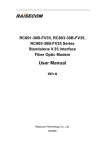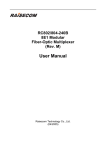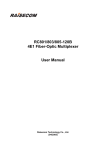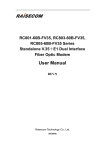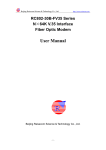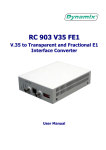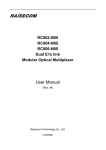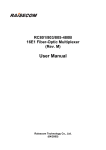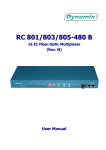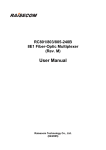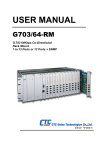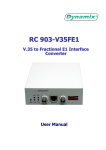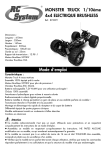Download Raisecom RC803 User manual
Transcript
RC802/804/806-30B-FV35 V.35 Interface Fiber Optic Modem User Manual (Rev. N) Raisecom Technology Co., Ltd. (05/2006) Raisecom Technology Co., Ltd 1. Cautions Please read the following notices carefully before installing and using the device, Raisecom does not respond to any loss that caused by violating safety notice. RC802/804/806-30B-FV35 device provide V.35 synchronization data interface which complied with ITU standard. It is seriously forbidden to insert or pull out V.35 cable when the converter and the other end device are both power on. This device also provide high sensitive optical interface. Before connect this device to Fiber media converter please test the transfer optical power of the latter. If the optical power is beyond the overload point of this device please don’t connect them, otherwise the optical module will be damaged. This RC802/804/806-30B-FV35 series fiber-optic modem is integrated device that has precise elements, please avoid violent shakes and impacts, and do not disassemble or maintain the device yourself. If it is required, please do it under the guide of our technical staff following in the steps of anti static. Please contact us if there is any need. There must be grounding protection for the sake of safety; do not disassemble the device yourself, we regard it as you waiver your rights of repair guarantee. 1 Raisecom Technology Co., Ltd Contents 1. Cautions ...........................................................................................................................................1 1. Overview............................................................................................................................................3 1.1. 1.2. 1.3. 2. Introduction ..............................................................................................................................3 Main Features ..........................................................................................................................3 Model Description ....................................................................................................................3 Parameters.......................................................................................................................................5 2.1. 2.2. 2.3. 2.4. 2.5. 2.6. 3. V.35 Interface Specification .....................................................................................................5 Optical Fiber Interface Specification.........................................................................................5 Cable type................................................................................................................................5 Power Consumption.................................................................................................................5 Structure character...................................................................................................................6 Ambience .................................................................................................................................6 How to use .......................................................................................................................................7 3.1. Description of the Front Panel..................................................................................................7 3.1.1. Power Supply/Error code test Indicator............................................................................7 3.1.2. Alarm Indicators ...............................................................................................................7 3.1.3. V.35 Interface...................................................................................................................7 Dip-switch Setup ......................................................................................................................8 3.2. 3.2.1. Setup of Timeslot Dip-switch (SW1 to SW4)....................................................................9 3.2.2. Function Dip-switch (SW5) ............................................................................................10 3.2.3. Function Choosing Dip-switch (SW6) ............................................................................12 3.3. Relationship between dip-switch and software configuration .................................................13 3.4. Basic Connection Type ..........................................................................................................13 3.4.1. Point-to-point, ‘Master Clock – Slave Clock’ Topology...................................................13 3.4.2. Point-to-point, ‘Terminal Clock – Slave Clock’ Topology................................................14 3.4.3. Extended Connection Type............................................................................................14 4. Installation & preparation................................................................................................................15 4.1. 4.2. 4.3. 4.4. 5. Before installation...................................................................................................................15 Cautions before Applying the Power Supply ..........................................................................16 Equipment deployment ..........................................................................................................16 Connection Diagnoses ...........................................................................................................16 F&Q................................................................................................................................................16 Appendix A: Introduction of Cable Making..............................................................................................18 1. 2. CBL-V35-HDB26M/M34F Cable making Instruction ..................................................................18 CBL-V35-HDB26M/M34M-X Cable making Instruction ..............................................................18 2 1. Overview 1.1. Introduction RC802/804/806-30B-FV35 series modular are devices that are deployed to transmit V.35 signals on fiber optics. They are widely used equipment in constructing Wide Area Networks, and provide solutions for connecting Routers distantly. RC802/804/806-30B-FV35 is modular type device and can be installed in our company’s RC002-16, RC002-4 and RC001-1 chassis. It supports network management function based on SNMP protocol, and it can be deployed at the local site to realize the remote management. 1.2. Main Features Provide a V.35 synchronized data DCE interface complied with ITU standard. Provide a dual- fiber or a single fiber dual-wavelength fiber interface. Complies with G.704 frame definition, realize bandwidth control on V.35 interface Whole fiber line alarm and internal E1 detection alarm, and provides local and remote alarm indication Provide local and remote loop-back test function to monitor line and help to deploy and maintain device. Support internal E1 data channel’s fractional /unframed (transparent) transfer mode. It can distribute timeslot freely in fractional mode. Provides three clock mode: master clock(internal clock),slave clock(follow fiber line clock),V.35 terminal clock( follow V.35 interface clock). When use fractional mode in a pair, the remote timeslot can follow local timeslot’s configuration. Internal error code test unit can make line detection and line test with several kinds of loop-back type. In fractional mode PCM30/PCM31 mode are optional and CRC4 verification function is auto-negotiation. Provide phase adjustment function of V.35 receiving data. Provide Fault pass function to transfer alarm of data line to V.35 interface, so that to judge E1 signal errors through router. Very large scale ASIC chips, low consumption; four level PCB design, high reliability. 1.3. Model Description RC800-30B-FV35 series modem includes below types: Article Description Module type, one V.35 interface (HDB 26 male ), one optical port, RC802-30B-FV35-S1 dual-fiber single mode (DSC), 0-25Km RC802-30B-FV35-S2 Module type, one V.35 interface (HDB 26 male ), one optical port, RC802-30B-FV35-S3 RC804-30B-FV35-S1 RC804-30B-FV35-S2 RC806-30B-FV35-S1 RC806-30B-FV35-S2 RC801-30B-FV35-S1 RC801-30B-FV35-S2 RC801-30B-FV35-S3 RC803-30B-FV35-S1 RC803-30B-FV35-S2 RC805-30B-FV35-S1 RC805-30B-FV35-S2 dual-fiber single mode (DSC), 10-60Km Module type, one V.35 interface (HDB 26 male ), one optical port, dual-fiber single mode (DSC), 15-120Km Module at central office, one V.35 interface (HDB 26 male ), one optical port, single fiber single mode 1310 (SC-PC), 0-25Km Module at central office, one V.35 interface (HDB 26 male ), one optical port, single fiber single mode 1310 (SC-APC), 10-50Km Customer premises module, one V.35 interface (HDB 26 male ), one optical port, single fiber single mode 1550 (SC-PC), 0-25Km Customer premises module, one V.35 interface (HDB 26 male ), one optical port, single fiber single mode 1550 (SC-PC), 10-50Km Standalone at the Customer Premises, one V.35 interface(M 34 Female),one optical port, dual-fiber single mode (DSC), 0-25KM Standalone at the Customer Premises, one V.35 interface(M 34 Female),one optical port, dual-fiber single mode (DSC), 10-60KM Standalone at the Customer Premises, one V.35 interface(M 34 Female),one optical port, dual-fiber single mode (DSC), 15-120KM Standalone at the Customer Premises, one V.35 interface(M 34 Female),one optical port, single fiber single mode 1310 (SC-PC), 0-25KM Standalone at the Customer Premises, one V.35 interface(M 34 Female),one optical port, single fiber single mode 1310 (SC-APC),10-50KM Standalone at the Customer Premises, one V.35 interface(M 34 Female),one optical port, single fiber single mode 1550 (SC-PC), 0-25KM Standalone at the Customer Premises, one V.35 interface(M 34 Female),one optical port, single fiber single mode 1550 (SC-APC), 10-50KM The content with shadow background of above table is the device type described in this manual. And others are standalone device at the customer premises. In addition, the AC and DC mark should be included in the article of these standalone devices to indicate 220V AC power supply or -48V DC power supply, e.g. “RC801-30B-FV35-S1-AC”. The following products can work in pairs: Central office module RC802-30B-FV35-S1 RC802-30B-FV35-S2 RC802-30B-FV35-S3 RC804-30B-FV35-S1 RC804-30B-FV35-S2 Customer premises module RC802-30B-FV35-S1 RC801-30B-FV35-S1 RC802-30B-FV35-S2 RC801-30B-FV35-S2 RC802-30B-FV35-S3 RC801-30B-FV35-S3 RC806-30B-FV35-S1 RC805-30B-FV35-S1 RC806-30B-FV35-S2 RC805-30B-FV35-S2 2. Parameters 2.1. V.35 Interface Specification Physical characteristics: Connector type: Working mode: Interface bit rate: Complies with V.35 interface standard of ITU HDB26 Female, transfer to ISO 2593 female connector by accessory cable CBL-V35-HDB26M/M34F DCE (support cross connection with other DCE device) V.35 interface bit rate is N×64Kbps(N=1~31)at E1 fractional mode V.35 interface bit rate is 2048Kbps at E1 transparent mode 2.2. Optical Fiber Interface Specification Bit rate: Line code: Fiber connecter: Product number 100Mbps 4B5B SC (FC available for some dual-fiber types) Transmit Laser Receiver Launch Over Receiving Typical Wavelength type type power load sensitivity transmission (Nm ) (dBmW) point (dBmW ) distance (dBm) (Km) RC802-30B-FV35-S1 1310 FP PIN -15,-8 >-8 <-34 0-25 RC802-30B-FV35-S2 1310 FP PIN -5,0 >-8 <-34 10-60 RC802-30B-FV35-S3 1550 DFB PIN -5,0 >-10 <-36 15-120 RC804-30B-FV35-S1 1310 FP PIN -12,-3 >-8 <-30 0-25 RC806-30B-FV35-S1 1550 DFB PIN -12,-3 >-8 <-30 0-25 RC804-30B-FV35-S2 1310 FP PIN -5,0 >-8 <-32 10-50 RC806-30B-FV35-S2 1550 DFB PIN -5,0 >-8 <-32 10-50 2.3. Cable type When connect this series product with DTE equipments such as routers through HDB26 interface, please use CBL-V35-HDB26M/M34F cable provided by Raisecom (standard accessory) to work with DTE/routers cable. When the CBL-V35-HDB26M/M34F cable is not long enough, please order it from Raisecom. When connect this series product with other venders DTE equipments, the cross cable CBL-V35-HDB26M/M34M-X is necessary, and please order it from Raisecom (non standard accessory). The default length of this cable is 2m. 2.4. Power Consumption Power consumption of whole device: ≤5W 2.5. Structure character Dimension: 91*25*178 (W*H*D) (mm) 2.6. Ambience Working temperature: 0 ~ 45℃ Humidity: ≤90% (25℃ non-condensing) 3. How to Use 3.1. Description of the Front Panel V35 TX RX ALM PWR/ PAT Figure 1 the front panel of RC802/804/806-30B-FV35 module 3.1.1. Power Supply/Error code test Indicator PWR power supply indicator (green/yellow): PWR/PAT Green/Yellow: Green, built-in power works in good condition. Yellow, when using built-in error code test function, if the fiber interface receives its own sending pseudo random sequence data the indicator will be in steady yellow. When it gets an error code the indicator will turns to green for at least 1 second. Steady off, the module is power off. 3.1.2. Alarm Indicators ALM Red/Yellow: Steady red, Local fiber signal has LOS, LOF, 1 E-3 error code alarm. Flash red, Remote fiber signal has LOS, LOF, 1 E-3 error code alarm. Steady Yellow, In fractional mode E1 data channel of local fiber signal has AIS alarm, G.704 LOF alarm, G.704 multi-LOF alarm, CRC4 verification error; In unframed (transparent) mode E1 data channel of local fiber signal has AIS alarm. Flash Yellow, Only occur in frame mode. E1 data channel of Remote fiber signal has AIS alarm, G.704 LOF alarm, G.704 multi-LOF alarm, CRC4 verification error alarm. Steady Off, no alarm and the line is normal. Notice: This series device has function of CRC4 verification auto-negotiation. When there is CRC4 verification information in the receiving E1 signal, the CRC4 verification function will be enabled automatically. When the CRC4 error occurs the CRC alarm indicator will be valid. If there is no CRC4 verification information the verification function will be disabled automatically and CRC alarm indicator is invalid. 3.1.3. V.35 Interface This left figure is HDB26 connector, and it can connect to ISO2593 connector by cable provided by Raisecom. This left figure is ISO2593 connector of standard V.35 interface. The connector used for this series device is DCE Connector Face – 34 Pin Female which can be connected to standard DTE cable. The description of this interface is as below table: I-Input; O-Output Signal Name Chassis Ground — CGND Signal Ground — GND Receive Data (A) — RD(A) Receive Data (B) — RD(B) Receive Timing (A) — RCK(A) Receive Timing (B) — RCK(B) Send Data (A) — TD(A) Send Data (B) — TD(B) Send Timing (A) — TCK(A) Send Timing (B) — TCK(B) Terminal Timing (A) — SCTE(A) Terminal Timing (B) — SCTE(B) Request to Send — RTS Clear to Send — CTS Data Set Ready — DSR Data Carrier Detect — DCD Data Terminal Ready — DTR ON ON OF F 1 2 3 4 5 6 In/Out O O O O I I O O I I I O O O I Pin Number A B R T V X P S Y AA U W C D E F H DIP 3.2. Dip-switch Setup There are six dip-switches on the bottom of the device which are named SW1, SW2, SW3, SW4, SW5 and SW6. Each DIP-switch is shown as the left figure, from left to right is the 1st bit to 8th bit, UP indicates ON and DOWN indicates OFF. Please configure these DIP-switch before installing the device to chassis. SW1 SW2 SW3 SW4 SW5 SW6 3.2.1. Setup of Timeslot Dip-switch (SW1 to SW4) Timeslot switches are SW1, SW2, SW3, SW4 “√” indicates enable; “×” indicates disable SW1 definition (default is all OFF) SET ON OFF 1st bit Frame Status Fractional Unframed 2nd bit TS1 √ × 3rd bit TS2 √ × 4th bit TS3 √ × 5th bit TS4 √ × 6th bit TS5 √ × 7th bit TS6 √ × 8th bit TS7 √ × 3rd bit TS10 √ × 4th bit TS11 √ × 5th bit TS12 √ × 6th bit TS13 √ × 7th bit TS14 √ × 8th bit TS15 √ × 3rd bit TS18 √ × 4th bit TS19 √ × 5th bit TS20 √ × 6th bit TS21 √ × 7th bit TS22 √ × 8th bit TS23 √ × 3rd bit TS26 √ × 4th bit TS27 √ × 5th bit TS28 √ × 6th bit TS29 √ × 7th bit TS30 √ × 8th bit TS31 √ × SW2 definition (default is all OFF) SET ON OFF 1st bit TS8 √ × 2nd bit TS9 √ × SW3 definition (default is all OFF) SET ON OFF 1st bit TS16 √ × 2nd bit TS17 √ × SW4 definition (default is all OFF) SET ON OFF 1st bit TS24 √ × 2nd bit TS25 √ × Notice: When the SW1-1 is OFF (unframed mode) the TS1 to TS31 is invalid. When the SW1-1 is ON( Fractional mode) the TS1 to TS31 is valid and can not be all OFF. That is to say there must be some timeslot is enabled. 3.2.2. Function Dip-switch (SW5) Function setup Dip-switch is SW5 In below table “ √” indicates enable; “×” indicates disable Definition of SW5 1st bit 2nd bit 3rd bit 4th bit 5th bit 6th bit 7th bit 8th bit Set Timing1 Timing2 TS_FLOW BERT RX CLK LP_EN LP_SEL RMT_CTL st Timeslot Clock 1 Clock Error Phase Two Loop Remote network Follow 2nd Code direction back management Test loop position control back ON * * √ √ Reverse √ Local Force remote OFF * * × × Positive × Remote Auto-negotiation 1. The 1st and 2nd bit: Clock mode choosing dip-switch Timing1, Timing2 (default is OFF) The Clock mode of device is defined by the 1st bit and 2nd bit of SW5, detail is shown in below table: SW5-1 SW5-2 Clock Mode OFF OFF Master Clock (Internal clock) OFF ON V.35 terminal Clock ( Follow V.35 interface clock) ON OFF ON ON Slave Clock ( Follow fiber line clock) 2. The 3rd bit: Timeslot auto follow function TS_FLOW (default OFF) SW5-3 Timeslot auto follow function ON Enable OFF Disable To make local timeslot follow remote timeslot, below four conditions should be ensured: (1) This series device is used point to point in pair. (2) There is no PCM device linked in E1 line. (3) Two end devices should not work in transparent mode. Firstly, the local device must be set to fractional mode. (The SW1-1 is ON and TS1 to TS31 should not be all OFF) (4) When local device works on slave clock mode the timeslot auto-follow function will be enabled automatically. When all of above condition is satisfied, set the SW5-3 of local device as ON to open timeslot auto-follow function, the timeslot and frame mode (PCM30/PCM31) of local device will follow the configurations of remote device automatically. 3. The 4th bit: Error code test function choosing dip-switch BERT (default OFF) SW5-4 Internal Error Code Test Function ON Enable OFF Disable There is an error code test unit inside this series device, and the main purpose of this unit is that produces pseudo random sequence (2E15-1) and sends them to optical line. This sequence can be uploaded to proper data channel through configuration, then via many loop back mode the returned sequence is sent to device for testing. The testing result will be displayed by the PWR/PAT indicator on front panel. When error code is captured the PWR/PAT indicator turns to green and keep for at least one second. If there is no new error code occur the PWR/PAT indicator will come back to steady yellow status. The device will add test sequence to user data channel after the error code test function is enabled. This function is available in fractional mode and unframed (transparent) mode, and when it is enabled the V.35 operation will intermit. Notice: The error code test function can be operated with many loop back test. When the local dual-direction loop back function is disable the loop back can be realized by fiber, but the dual-fiber S3 and all single fiber are forbidden. At the time when PWR/PAT indicator is steady yellow it indicates that correct test code was received. If the remote dual-direction loop back is enabled accompanied with error code test, it means the whole information process will be tested. 4. The 5th bit: RC CLK Phase choosing dip-switch (default OFF) SW5-5 ON OFF Phase Choosing RX CLK Reverse Phase RX CLK Positive Phase The RX CLK phase choosing is provided according to the different V.35 clock and data phase of different brand router. On Cisco series router the test result of V.35 synchronization WAN interface is passing when this device is connected and its RX CLK is Positive. RX CLK is Positive: Data will be sent to RD signal during RX CLK falling edge. RX CLK RD RX CLK is Reverse: Data will be sent to RD signal during RX CLK rising edge. RX CLK RD Notice: The relationship of TX CLK and TD phase of this series device is auto-adjusted, so users need not to configure it. 5. The 6th and 7th bit: Loop back dip-switch (default OFF) ON OFF SW5-6 Dual-direction loop back enable Dual-direction loop back disable SW5-7 Local loop back Remote loop back DTE or Error code equipment V.35 Local (Master) Remote (Slave) Fiber DTE or Error code equipment Local loop back: it actually includes local two direction loop back. Those are internal loop back on V.35 interface and external loop back on fiber interface, as above figure. To perform local loop back test please set SW5-6 and SW5-7 as ON. The interface inquiry result of local and remote router is loop back if the fiber and V.35 cable is good. DTE or Error code equipment V.35 Local (Master) Fiber Remote (Slave) DTE or Error code equipment Remote loop back: it actually includes remote two direction loop back. Local device’s fiber interface loop back toward local device and its V.35 interface loop back toward DTE equipment, as above figure. To perform remote loop back test please set SW5-6 ON and SW5-7 as OFF. The interface inquiry result of local and remote router is already loop back if the fiber and V.35 cable is good. 6. The 8th bit: Remote network management dip-switch (default OFF) SW5-8 ON OFF Remote Management Status Force managed by remote device The network management position is auto-negotiation When two devices of this series are used in pair, if remote device is inserted in RC001-1 single slot chassis it will work on “managed by remote device” mode automatically, but if it is inserted in RC002-16 chassis it must be configured as “Force managed by remote device”. If the device is for local management its SW5-8 must be OFF. Notice: If two of this using in pair device are both inserted in RC002-16 chassis, one of them should be configured to “Force managed by remote device” mode no matter the network management software is used or not, otherwise the device will runs abnormally. 3.2.3. Function Choosing Dip-switch (SW6) Definition of SW6 (default OFF): 1st bit Definition Fault Pass ON Enable OFF Disable 2nd bit 3rd bit 4th bit 5th bit 6th bit 7th bit 8th bit Reserved Reserved Reserved Vendor configuration dip-switch Please don’t change normal normal normal 1. The 1st bit: Fault Pass choosing dip-switch SW6-1 ON Fault Pass Enable OFF Disable When fault pass enable, alarms of optical interface Rx and Tx will be transferred to DCD and CTS signal on V.35 interface; When fault pass disable the DSR, DCD and CTS signals of V.35 interface will be valid. When fault pass enable, if the device has local alarm (errors on fiber Rx interface) the DCD signal of V.35 interface will close and DTE device should have some denotation. When fault pass enable, if the device has remote alarm (errors on fiber Tx interface) the CTS signal of V.35 interface will close and DTE device should have some denotation. After power on the DSR signal of this series device will be forever valid. 2. The 2nd, 3rd, 4th bit: Reserved dip-switch. These bit are reserved and for internal test. They should be all OFF when work normally. 3. The 5th, 6th, 7th, 8th bit: Vendor configuration dip-switch These bit are configured by producer and please don’t change. 3.3. Relationship between dip-switch and software configuration The corresponding relationship of above device dip-switch and network management ability is shown as below table: Dip-switch SW1~SW4 SW5 SW6 The configuration can be changed by software or not Can Can Can not 3.4. Basic Connection Type The connection topologies introduced in this part is only for user reference. Users are advised to design and deploy the most appropriate topology according to their specific environment. 3.4.1. Point-to-point, ‘Master Clock – Slave Clock’ Topology When connecting Routers or other V.35 interface equipment point to point, routers should work in DTE mode. For the convenience of installation and test, it is advised to set the local modem ‘Master Clock Mode’, and remote modem ‘Slave Clock Mode’. That is, the timing resource is from the local modem. In “Master Clock-Slave Clock” topology, if DXC, MUX devices are in E1 link, the DXC, MUX and remote modem should all be slave clock mode (follow the clock of E1 link) Master Clock (Clock Source) Slave Clock Fiber RC802-30BFV35 RC801-30BFV35 V.35 DTE wire V.35 DTE wire Router Router 3.4.2. Point-to-point, ‘Terminal Clock – Slave Clock’ Topology When the remote DTE must follow the timing resource of local V.35 clock, that is to say the TX CLOCK of local TX is inner clock source. In this condition, it is advised to set the local modem ‘Terminal Clock Mode’, and remote modem ‘Slave Clock Mode’. In (Terminal Clock-Slave Clock) topology, if DXC, MUX devices are in E1 link, the DXC, MUX and remote modem should all be slave clock mode (follow the clock of E1 link). Terminal Clock Slave Clock Fiber RC802-30BFV35 RC801-30BFV35 V.35 DTE wire V.35 DTE wire Router Router Clock Source 3.4.3. Extended Connection Type Fiber RC802-30B-FV35 E1 RC 802-30B V.35 DTE wire E1 cable Router ATM /DDN/Router If E1 interface equipment is in user premise, RC802-30B can be in remote site and RC802-30B-FV35 in local site as the above figure. Please be attention to the clock mode, if the E1 interface of ATM is in master clock mode, then local RC802-30B-FV35 should be in slave clock mode. 4. Installation & preparation 4.1. Before installation Please make sure that the V35 cable you use matches the equipment you want to connect Please check if the equipment has been destroyed If you do not use network management, please configure the device through DIP-switch be installation. 4.2. Cautions before Applying the Power Supply It is strictly forbidden to hot-swap the V.35 interface cable. If adopts the DC –48V power supply, please first connect the PGND (Protecting Ground the middle pin). They must not be reversely connected, connect -48 with low voltage input, BGND with high voltage input 4.3. Equipment deployment In computer room and keep the room clean Check the DIP-switch configuration other parameters again 4.4. Connection Diagnoses Check if there is any alarm on local equipment Test if data communication can be performed between local DTE and remote equipment If the test is failed, please try the following steps. 1. Local bi-direction loop-back test. Refer to previous dip-switch setup for details. If the Router indicates loop-back successful, the V.35 interface is working in good condition. If the Router indicates loop-back fails, please first check the timing resource and bandwidth setup at local site, and try to adjust the TX CLK and RX CLK phase option switch. 2. If the E1 interface of remote equipment is connected with the ATM E1 interface, please make sure that there is only on clock source in the network and the time slot configuration of both equipments is the same If the link still remains disconnected, please contact the technical support from the local distributors. 5. F&Q If there is any problem during installation and operation, please try the following solutions. If the problems still cannot be solved, please contact distributors for technical support. Green PWR indicator is not on Answer: Power supply fails. Check whether the power supply of chassis is working properly. YELLOW steady on in unframed mode after connecting optic fiber Answer: in unframed mode there will be yellow steady on when optical interface receives AIS. If the line works normal, please check the following conditions: V35 interface of remote site device does not connect to router, remote router is powered off or V35 interface of remote router is shutdown. When work with few venders’ router, there maybe yellow steady on or interval on, but they can communicate with each other. It is because remote router will send AIS when there is no data transporting. Enable loop back function, use the inner error code tester and power on, but the status of PWR/PAT is not stable. Answer: first make sure that the connection of optical interface is normal and there is no error code, and then make sure there is no loop back configuration on remote site equipment. In the first 15 seconds after being powered on, the local and remote equipments will change information with each other, it is normal. Please wait for some moments and then judge error code status according to PWR/PAT indicator. PRI of network management and DIP-switch Answer: CPU will read the DIP-switch configuration once it is powered on, and then network management has higher privilege. (Notice that network management cannot configure Fault-Pass-Through function) Severe Packet Loss Answer: this may be caused by the following conditions: There is more than one clock source in the network; Check the status of router’s V35 interface, if there is RX/TX data error, please adjust RX CLK phase of local and remote device. Compatibility Answer: the optic interface of this equipment deploys PDH technology, and can only communicate with Raisecom RC800 series optical multiplexer. If the remote site is RC800-30B series single E1 multiplexer, the E1 interface can communicate with all the other venders’ equipments. Compatibility of V35 interface Answer: RC800-30B-FV35 series can work with other Raisecom V35 equipments, and can provide a flexible network topology, including: Standalone RC903-V35FE1 V35 to fractional E1 interface converter Modular RC904-V35FE1 V35 to fractional E1 interface converter SUBM-FV35 (N×64K V.35) which is installed in extension slot of some Raisecom optical multiplexer Appendix A: Introduction of Cable Making 1. CBL-V35-HDB26M/M34F Cable making Instruction Description: DCE cable for HDB26 Male interface to M34 Female interface Note: The default length of CBL-V35-HDB26M/M34F-2M cable is 2.0m. You can order other length cable according to your requirement. HDB26 V.35 standard ISO2593Female Male name (M34 Female) 1 PGND A 2 TD(A) P 3 RD(A) R 4 RTS C 5 CTS D 6 DSR E 7 GND B 8 DCD F 11 TD(B) S 15 TCP(A) Y 16 SCTE(B) W 17 RCP(A) V 20 DTR H 21 RD(B) T 23 TCP(B) AA 24 SCTE(A) U 25 RCP(B) X Other pins have no connection. Request: The cable material is not lower than 80℃ 30V. 2. CBL-V35-HDB26M/M34M-X Cable making Instruction This cable is cross connection cable which is used to link the V.35 (DCE) interface of node equipment as DDN to the V.35 interface of the RC802-30B-FV35 series device. Using this cable if the clock resource is provided by node equipment the RC802-30B-FV35 series device should be configured to V.35 terminal mode. If the clock is provided by fiber-optic multiplexer the node equipment’s clock should be slave mode. Description: Cross cable for HDB26 Male interface to M34 Male interface M34 Male interface Signal name Pin NO. TD(A) P TD(B) S HDB26 Male interface Pin NO. Signal name 3 RD(A) 21 RD(B) RD(A) RD(B) RCLK(A) RCLK(B) SCTE(A) SCTE(B) R T V X U W 2 11 24 16 17 25 TD(A) TD(B) SCTE(A) SCTE(B) RCLK(A) RCLK(B) SGND GND TCLK(A) TCLK(B) A B Y AA 1 7 15 23 SGND GND TCLK(A) TCLK(B) DCD DSR CTS RTS DTR F E D C H 8 6 5 4 20 DCD DSR CTS RTS DTR disconnect disconnect Other pins have no connection. Request: The cable material is not lower than 80℃ 30V. BROADBAND to RAISECOM @2005 Raisecom Technology Co., Ltd. All trademarks are the property of their respective owners. Technical information may be subject to change without prior notification.






















